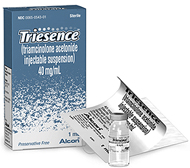Product
Triesence
Approval Date
November 29, 2007
Release Date
March 27, 2008
Companies
Alcon
Class
Glucocorticoid
Indication
Sympathetic ophthalmia, temporal arteritis, uveitis, andocular inflammatory conditions unresponsive to topical corticosteroids.Visualization during vitrectomy.
Active Ingredient
Triamcinolone acetonide 40mg/mL; susp for intravitreal inj.
Agency Roster
In-House (professional)
No consumer AOR
Marketing Strategy/Execution
Triesence is one of the drugs that recently prompted Novartis to plunk down $11billion for a minority, and possibly larger, stake in eyecare firm Alcon. Whileits active ingredient has been used for years to treat retinal disease,Triesence’s distinction as the only triamcinolone approved by the FDA in asterile, preservative-free formulation for ophthalmic use may win favor amongdoctors who need to help patients maintain visualization during vitrectomy, asurgical procedure, or for ocular inflammatory conditions. The company toldMM&M that its vitreoretinal sales force will emphasize“ophthalmic by design,” aided by KOLs, advertising and education.
Recent MM&MCoverage
Product News
Also in the Pipeline(according to Adis R&D Insight)
Drug: AzaSite Otic/AzaSite Plus
Manufacturer: InSite Vision
Indication: Ocular Inflammation (Blepharoconjunctivitis)
Active ingredient: Azithromycin/dexamethasone combination
Phase: III
Source: Wolters Kluwer Health
Pharmacology
Triesence is a synthetic corticosteroid analog primarilyused as an anti-inflammatory agent. It possesses glucocorticoid activitytypical of this class of drug, but with little or no mineralocorticoidactivity. Corticosteroids have been shown to depress the production ofeosinophils and lymphocytes, while stimulating erythropoiesis and production ofpolymorphonuclear leukocytes. Inflammatory processes (eg, edema, fibrindeposition, capillary dilatation, migration of leukocytes, and phagocytosis)and the later stages of wound healing (eg, capillary proliferation, depositionof collagen, cicatrization) are inhibited.
Adverse Reactions
Elevated intraocular pressure (monitor), cataracts,endophthalmitis, hypopyon, inj site reactions, glaucoma, vitreous floaters,retinal pigment epithelium detachment, optic disc vascular disorder, eyeinflammation, conjunctival hemorrhage, reduced visual acuity, HPA axissuppression, masks infection, increased susceptibility to infection, hypertension,hypokalemia, weight gain, osteoporosis, behavioral or mood disturbances,myopathy, Kaposi‘ssarcoma.
Adults
Give anesthesia and broad-spectrum microbicide prior to use.Ophthalmic diseases: initially 4mg (100microliters); may repeat if needed.Visualization: 1–4mg(25–100microliters)intravitreally.
Children
Give anesthesia and broad-spectrum microbicide prior to use.Ophthalmic diseases: initially 4mg (100microliters); may repeat if needed.Visualization: 1–4mg(25–100microliters)intravitreally.
Contraindications
Systemic fungal infections. Live vaccination.
Precautions
Not for IV administration. Ocular herpes simplex. Cerebralmalaria: not recommended. Tuberculosis. If exposed to chickenpox or measles,consider prophylactic passive immune therapy. Strongyloides infestation. Latentamebiasis. Thyroid disorders. Diabetes. CHF. Hypertension. Recent MI. Renalinsufficiency. GI perforation. Diverticulitis. Intestinal anastomoses. Pepticulcer. Myasthenia gravis. Hypoprothrombinemia. Monitor for osteoporosis (esp.postmenopausal women) if on long-term therapy; do bone density tests.Supplement with additional steroids in physiologic stress. Monitor growth,weight, blood pressure, fluid and electrolyte balance. Avoid abrupt cessation.Pregnancy (Cat.D); (avoid in 1st trimester). Nursing mothers.
Interactions
Potentiated by CYP3A4 inhibitors (eg, ketoconazole,macrolides), cyclosporine, estrogens. Antagonized by CYP3A4 inducers (eg,barbiturates, phenytoin, carbamazepine, rifampin), ephedrine, cholestyramine.May potentiate cyclosporine. May antagonize anticoagulants (monitor),isoniazid. Increased risk of arrhythmias with digitalis. May need to adjust doseof antidiabetic agents. Increased GI effects with aspirin, other NSAIDs.Monitor for hypokalemia with potassium-depleting drugs (eg, amphotericin B,diuretics). Withdraw anticholinesterase agents at least 24 hours beforestarting corticosteroid therapy. May suppress reactions to skin tests.









